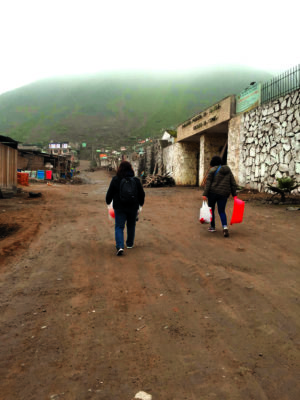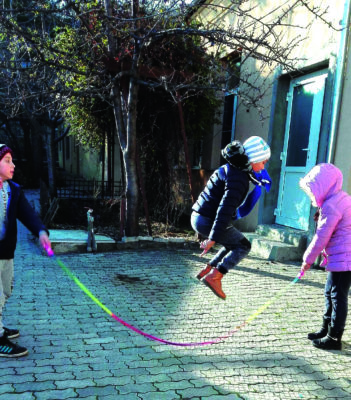As this issue of The Cry focusing on our Lifestyle Celebration of brokenness publishes, the season of Lent (March 6- April 18) is upon us.
Lent is a time within the Church year that we recognize that the journey of faith entails navigating our own brokenness and the brokenness of our surrounding world. Lent lasts for 40 days to correspond with the time of temptation and seasoning that Jesus experienced in the desert wilderness before His entry into public ministry (Lk. 4:1–13; Mt. 4:1–11).
I appreciate that much of the Church does not officially count Sundays as part of the Lenten timeline. This means that Lent always runs a bit longer than 40 days on the regular calendar. The Church has chosen to not count Sundays as a sign that we experience multiple, ongoing Easters/Resurrections/Redemptions/Transformations in the midst of traversing brokenness.
Hardship and Hope hold hands.
When one experiences a life of significant privilege it can be daunting to hear that brokenness accompanies hope. When one’s life is fraught with brokenness, hearing that you are not abandoned by hope is celebratory indeed. No matter from whence one hails, both brokenness and hope are with us all.
Intriguingly, God – the Creator and Sustainer of the universe – chose to experience vulnerability and harm for our sakes as part of the process of best coming to Know and Love us. God didn’t just magically wave away the brokenness of the world. Rather, God dove into the brokenness with us. God made sure that Hope was present in the midst of hardship.

Throughout the Gospels, we are exhorted to seek to live like Jesus lived. We are told that if we are doing this reasonably well, then we should not expect outcomes that significantly vary from those that the Lord experienced (Mt. 10:24-25; Lk. 6:40; Jn. 13:16; Jn. 15:20). We should expect to experience both brokenness and hope – crucifixions and resurrections.
How might leaning into the approachability of God via the intimate, vulnerable presence of Jesus affect our theological understandings and methodological practices? What might we learn from more fully accepting brokenness as a vital, necessary component for seeking to understand and to share the Love of God? How do we go about seeking to live like Jesus, experiencing both brokenness and hope?
Some thoughts:
1.As we have seen above, at significant expense, Jesus came to live with and among. “God so loved that He gave…” (Jn. 3:16) Jesus came; God stays with us (Mt. 28:20, Jn. 14:16; Jn. 16:7). The all-powerful God did not immediately seek to fix everything, but we see that Jesus always Loves well. We too can each do this in our own way. Certainly, all around the world Word Made Flesh staff share their time, talents, and resources through living with and among people. As much as they are able, seeking to follow in the footsteps of the Lord, WMF staff also arrive and stay. WMF folks accompany others; they walk together in community. They experience camaraderie of joy and solidarity of brokenness. This is not to suggest that joys or brokenness are ever exactly similar for anyone, but authenticity of lived experience arises through lived fellowship.
2. Like God, we can seek to not look at outward appearances, but rather seek to look at the heart (1 Sa. 16:7).
A person can look fabulous on the outside and be deeply broken within.
A person can look fabulous on the outside and hold deep wells of goodness within.
A person can look broken on the outside and be deeply broken within.
A person can look broken on the outside and hold deep wells of goodness within.
We can ask the Lord that we would be able to see with the eyes of our heart (Ep. 1:18-19) and not just with the eyes in our head. We can ask, beyond externalities, for wisdom and discernment to see the Goodness of God in every person (Ge. 1:26-28; Ge. 9:5-6; Ja. 3:9).
3. We can ask the Lord to help us recognize that not only people experience brokenness, but systems experience brokenness. Systems are made up of people experiencing varying levels of brokenness. It quickly makes sense that systems might well exhibit and perpetuate their own characteristics of brokenness.
Personal and social brokenness mutually reinforcing each other can become an extraordinarily vicious cycle.
Around the world, Word Made Flesh communities exist right in the midst of such brokenness that manifests as both systemic/social and personal marginalizations and oppressions. WMF communities seek to interrupt cycles of harm and initiate and grow cycles of goodness. Our communities seek to be places of peace, hope, love, welcome, joy, comfort, and stability functioning in antithesis to surrounding injustices and chaos.

4. Finally, we can recognize that while we all experience brokenness differently, we all experience brokenness. Brokenness is not foreign to any of us. If the Lord gives us the strength to be vulnerable in the ways that He showed us are possible through His life, then we can all meet each other in our places of limitation and lack. In Christ, we can meet each other in our brokenness and begin to find the nascent first fruits of new life in such meeting.
However, some of us may be more aware of our brokenness than others. Developing awareness becomes an important component of leaning forward into God’s Love for ourselves and others.
Mother Teresa writes about how recognizing our own brokenness can be key to allowing God to use us to aid in the healing of the brokenness of others,
…The knowledge of our sin helps us to rise….Knowledge of self is very necessary for confession. That is why the saints could say they were wicked criminals. They saw God and then saw themselves, and they saw the difference. We become hurt because we do not know ourselves, and our eyes are not fixed on God alone; so we do not have real knowledge of God. When the saints looked upon themselves with such horror, they really meant it. They were not pretending.
Knowledge of ourselves will help us to rise up, whereas sin and weakness will lead to despondency. Deep confidence and trust will come through knowledge. Then you will turn to Jesus to support you in your weakness, whereas if you think you are strong, you will [think you do] not need our Lord….Reconciliation begins with ourselves. It begins with a pure heart, a heart that is able to see God in others.1
Recognizing that we all have sinned and fall short of the glory of God (Ro. 3:23), that we all have brokenness as part of our Being, that we are mutual pilgrims longing for redemption and reconciliation in this world, allows for a recognition of kinship that bridges differentiating divides. Where at first we might not have seen connection because of difference, we now begin to see not only connection, but kinship.
We begin to see the Goodness of God in others through and beyond the mutuality of our brokenness.
When we approach one another in honest, humble recognition of mutual lack, it leaves the Lord great space to enact mutual redemption and healing. This becomes a foundation for a strong, healthy, vibrant community.
In our weakness God is made strong (2 Co. 12:9-11). We recognize that though God allows us to participate in the process of help and healing, ultimately it is the Lord that does this. We are simply conduits facilitating power. We are the branches…God is the vine (Jn. 15:5).
It is through the lens of brokenness that God offers us Grace to see into the wholistic Hope of God.
God teaches us that resurrection becomes possible via crucifixion.
I love the bittersweet story of the road to Emmaus (Luke 24:13-35). It’s tragic that the disciples were unable to recognize Jesus after a whole day of walking together. That is, they were unable to recognize Him until they invited Him in, He broke the bread, and gave it to them. In the brokenness (and the giving) they saw Him!
In this issue of The Cry you’ll read all kinds of important reflections on brokenness. I hope that like the disciples on the Emmaus road, in retrospect you’ll more fully realize God’s presence has been with you all along, “were not our hearts burning within us while he talked…?”
“Inasmuch as you have done it unto the least of these my brethren you have done it unto Me” (Mt. 25:40).
Who have you been talking with on the road? How has Jesus been with you in the midst of your own and others’ brokenness?
Friends, we are called to be like our Lord.
May you be broken and give yourselves for the sake of others.
Being broken is hard. It is excruciating.
Yet, it is in breaking that we ironically find the power and the joy of the Gospel.
“…unless a grain of wheat falls into the earth and dies, it remains just a single grain; but if it dies, it bears much fruit” (Jn. 12:24).
Look beyond the surface…
Look deeper than the difference…
Can you feel your hearts burn? Can you see Him?
Everywhere you go, with every person you’re with, He’s available and waiting the whole time.
Start saying Yes to Him today in your every encounter, in your ongoing brokenness.
Surely, “He who began a good work in you, will be faithful to complete it” (Ph. 1:6).

Clint Baldwin
Executive Director of Word Made Flesh
clint.baldwin@wordmadeflesh.com
1 Benenate, B., & Durepos, J. (1997). Mother Teresa: No Greater Love. New York: MJF Books. pp. 113-114.
